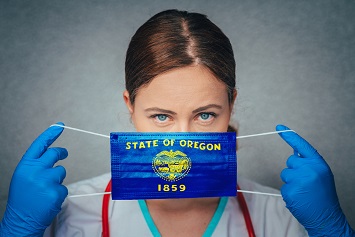This week, Oregon may become the third state to establish an emergency workplace health standard for coronavirus disease 2019 (COVID-19) exposures. COVID-19 is a respiratory disease caused by the SARS-CoV-2 virus.
There is no federal standard for COVID-19 or any other airborne infections, but Virginia and Michigan created emergency COVID-19 standards earlier this year.
The Oregon Occupational Safety and Health Administration (OSHA) released the fourth draft of its rule text on October 23 and accepted public comment through October 30. The rule would require cloth face coverings in indoor spaces, regardless of physical distancing. The agency expects to adopt a final temporary standard this week. It would take effect 10 days after adoption.
The state agency also will develop a permanent infectious disease standard. California has an Airborne Transmissible Disease (ATD) standard that applies to correctional and healthcare facilities, as well as public services. Oregon’s emergency COVID-19 standard would apply to all workplaces under Oregon OSHA’s authority.
Oregon’s emergency standard will remain in effect 180 days from adoption, unless it is repealed sooner. The agency will immediately begin work on a permanent infectious disease rule that will include requirements specific to COVID-19.
The Oregon Health Authority on October 19 issued a statewide mask order for all people aged 5 and older. The order applies to all private and public workplaces—banks, classrooms, construction sites, grocery stores, pharmacies, public transit, offices, personal services providers like barbershops and hair and nail salons, restaurants, bars, and retail stores.
In addition to the face covering requirement, the Oregon emergency workplace standard would require employers to perform exposure risks assessments and develop, implement, and maintain an infection prevention plan. Employers must complete the assessment and establish an infection control program within a month of the emergency rule’s adoption.
Under the emergency standard, employers would be required to:
- Ensure that all work activities and workflows are designed to maintain a distance of 6 feet or more between individuals.
- Also maintain face coverings and physical distancing at outdoor worksites and premises.
- Clean or sanitize all common areas, shared equipment, and high-touch surfaces—once every 24 hours in workplaces occupied less than 12 hours a day and twice every 24 hours in those occupied more than 12 hours a day.
- Permanently post a “COVID-19 Hazards Poster,” provided by Oregon OSHA, in a conspicuous manner in a central location where workers can be expected to see it.
- Maximize the amount of outside air circulated through the existing workplace heating, ventilation, and air conditioning (HVAC) system to the extent capable no later than 2 months after adoption of the rule.
Employers also must provide employee education and training regarding COVID-19 within 6 weeks. They also must develop infection notification procedures.
Employers must provide space for local or state public health authorities to conduct COVID-19 testing. Public health authorities may order the medical removal of workers for quarantine or isolation.
Oregon also would have industry-specific requirements for public-facing establishments like bars and restaurants; retail stores; and schools, colleges, and universities, as well as construction, fire and emergency medical services, jails, and law enforcement.
The permanent infectious disease rulemaking will undergo the agency’s regular rulemaking process as required by the state’s Administrative Procedures Act. Procedures include accepting public comment and holding public hearings before any final decision is made on a final rule.
Oregon OSHA also is working on permanent standards increasing minimum and maximum penalties and establishing definitions for employer knowledge and diligence and unpreventable employee behavior.

